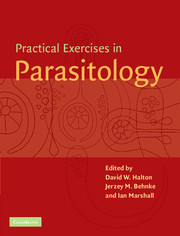Book contents
- Frontmatter
- Contents
- List of contributors
- Preface
- General advice
- 1 Observational Exercises on Parasites
- 2 Ecology
- 3 Physiology and Biochemistry
- 4 Pathology and Immunology
- 4.1 Encapsulation of foreign matter (not-self) by earthworms
- 4.2 Opsonisation of trypanosomes
- 4.3 Production and screening of monoclonal antibodies against Leishmania promastigotes
- 4.4 Pathological effects of Mesocestoides corti and Schistosoma mansoni
- 4.5 Quantification of lymphocyte populations in the spleen and thymus
- 4.6 Use of basic indirect ELISA for the detection of antibodies produced by experimental immunisation
- 4.7 SDS PAGE and Western blotting for the detection of antibodies produced by experimental immunisation
- 5 Chemotherapy
- 6 Molecular Parasitology
- 7 Behaviour
- Appendix 1 Reagent index
- Appendix 2 UK suppliers
- Appendix 3 US suppliers
- Index
4.5 - Quantification of lymphocyte populations in the spleen and thymus
Published online by Cambridge University Press: 05 June 2012
- Frontmatter
- Contents
- List of contributors
- Preface
- General advice
- 1 Observational Exercises on Parasites
- 2 Ecology
- 3 Physiology and Biochemistry
- 4 Pathology and Immunology
- 4.1 Encapsulation of foreign matter (not-self) by earthworms
- 4.2 Opsonisation of trypanosomes
- 4.3 Production and screening of monoclonal antibodies against Leishmania promastigotes
- 4.4 Pathological effects of Mesocestoides corti and Schistosoma mansoni
- 4.5 Quantification of lymphocyte populations in the spleen and thymus
- 4.6 Use of basic indirect ELISA for the detection of antibodies produced by experimental immunisation
- 4.7 SDS PAGE and Western blotting for the detection of antibodies produced by experimental immunisation
- 5 Chemotherapy
- 6 Molecular Parasitology
- 7 Behaviour
- Appendix 1 Reagent index
- Appendix 2 UK suppliers
- Appendix 3 US suppliers
- Index
Summary
Aims and objectives
This exercise is designed to demonstrate:
Methods for quantifying cellular (lymphoid) changes in body organs.
The morphology of the mononuclear cell types.
Changes in the lymphoid cell population during the course of an infection.
Introduction
The dominant cell types that are involved in an active immune response are the lymphocytes, of which there are two main classes: B-lymphocytes and T-lymphocytes. Morphologically, they are very similar and can only be distinguished by specialised staining techniques.
Lymphocytes have a limited life-span and are continuously replenished, hence the number of both circulating and organbased lymphocytes is relatively stable. If an infection becomes established, antigenic molecules derived from the invading pathogen are transported via antigen-presenting cells to the spleen and lymph nodes.
The presentation of the antigen to the T cells with specific antigen receptors (mainly T-helper and to a lesser extent T-cytotoxic) stimulates the release of a range of cytokines, interleukins and growth factors, which, in turn, promote cell proliferation (cloning) of primed lymphocytes. Hence the numbers of resident lymphocytes in both the T and B cell zones increase.
The total number of viable lymphocytes in various organs can be estimated by a simple extraction technique. This method involves identifying and dissecting out the lymphoid organs (spleen, thymus and lymph nodes) followed by extraction of the lymphocytes, staining and quantification.
- Type
- Chapter
- Information
- Practical Exercises in Parasitology , pp. 277 - 282Publisher: Cambridge University PressPrint publication year: 2001

